Daikon and Konnyaku Miso Dengaku (sweet miso glaze) is a Japanese appetizer that reminds me of my trips to Kyoto (where tofu is a specialty). Some of my tastiest memories are eating the dengaku glazes in the many restaurants that serve it. I took that nostalgia and desire to eat more miso and applied it to daikon radish and konnyaku. The flavor is perfect, with a delicate balance between sweet and salty. This dengaku miso glaze is one you can apply to many other foods. If only you dare…
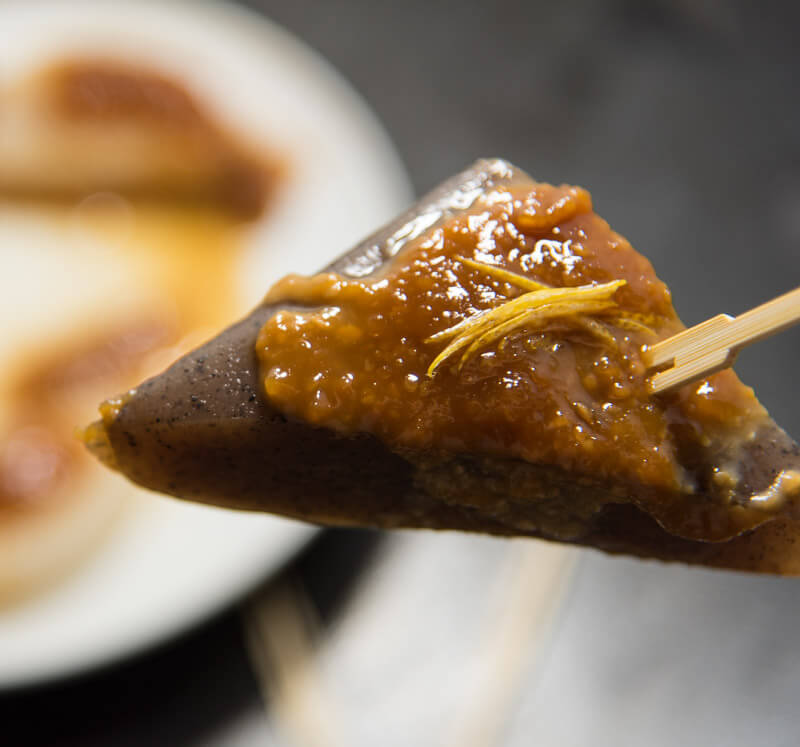
Miso Dengaku(味噌田楽)the Ultimate Sweet and Salty Vegetable Glaze
Miso dengaku is a Japanese miso glaze that is packed with flavor.
It’s characteristically bold thanks to a heavy miso component.
And it get’s a boost from several flavor enhancers like sake, mirin, sugar and other ingredients depending on the recipe.
Miso dengaku is sweet and salty, but I like to make it a little bit on the saltier side. How about you?
It goes extremely well on tofu and some of my favorite vegetables like eggplant and daikon.
But it’s quite versatile and you can use it on many other things like scallops, pork, potatoes and even oden.
If you aren’t sold yet, and you’ve never tried miso dengaku.
This and eggplant (nasu dengaku– [version 2 will be posted soon]) are good options to get started.
Next time I’ll make it with tofu which is my absolute favorite.
Konnyaku (konjac)
The konnyaku triangles don’t have much flavor on it’s own, so it’s the perfect vehicle to eat the miso dengaku glaze.
The konnyaku is the block form of shirataki noodles which are both made from the same thing.
Shirataki noodles can be used in various dishes like sukiyaki or shabu shabu.
Taking konnyaku out of the package is probably most unpleasant part about preparing this dish.
It always has a funky smell, but with a quick rinse and after cooking you won’t even notice it.
Plus it’s a negative calorie food.
That means you burn more calories digesting it, than you absorb from it. Know another vegetable that is negative calorie? Celery!
For this recipe, I lightly seasoned the daikon and the konnyaku with half-strength dashi stock and a little soy sauce.
If you want a stronger flavor, you can use full strength dashi.
Up to you.
That’s the freedom of cooking at home!
However, I think the dengaku glaze has plenty of flavor so that is why I go with less seasoning.
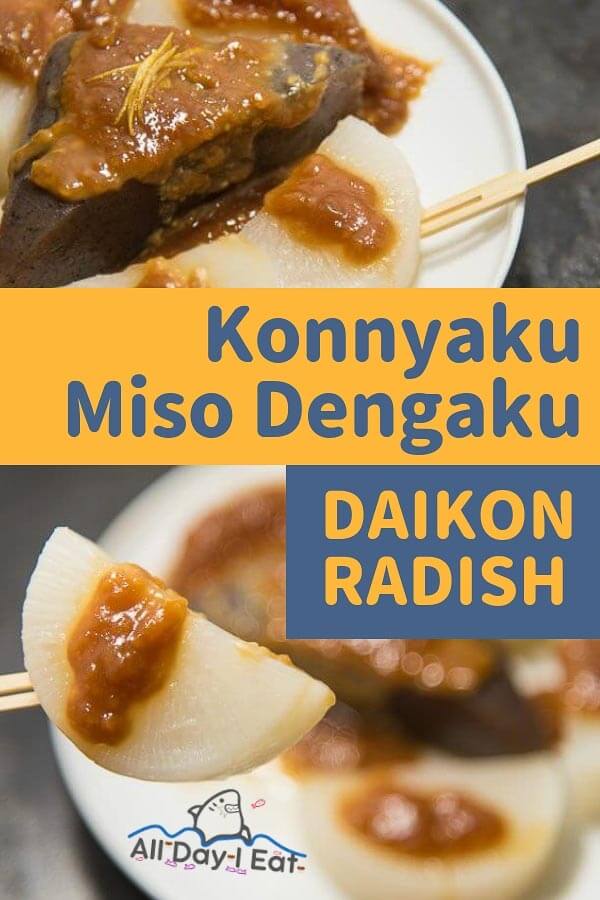
Why Daikon is bitter (Japanese radish)
Did you know daikon flavor varies depending on the season?
During the winter it’s sweeter, and summer more bitter.
The way that you cut the daikon can also affect the bitterness.
The bitter flavor in radishes like daikon can be attributed to this compound- Allyl isothiocyanate
Apparently, if you cut length wise (with the grain) the flavor will be less bitter as you are cutting with the grain.
Cutting with the grain on daikon means you’re cutting with the fibers that extend up/down and breaking less cells.
Breaking less cells means less allyl isothiocyanates and equals less bitter daikon.
I learned all this a couple of years ago, when I saw this Japanese TV show called Sore-dame(それダメ)
🙂
How to Improve the Flavor of your Daikon
I precooked each slice of daikon in togijiru (とぎ汁) for about 20 minutes.
Togijiru is the rinse water that you can collect when rinsing rice.
I make sure to put in roughly 4 cups of water and agitate the rice to get as much of the starch into the water on the first rinse.
Then I strain the rice rinse water into a 4 cup pyrex.
And jyann!! (ジャーン = ta-da!)
You have togijiru!
Togijiru should be milky white and contains all those rice starches that you don’t want on your rice.
It helps to not only keep the daikon white, but also remove some of the bitterness daikon can sometimes have.
Togijiru can also be used to remove the garlic smell from your fingers and cosmetically to moisturize your face.
As well as many other things.
Makes you think twice about throwing rice rinse water down the drain now, doesn’t it?
Watch the live replay video below to learn how to prepare three different dishes using miso.
- Misoni (miso simmered Mackerel)
- Daikon and Konnyaku Miso Dengaku (this recipe)
- Eggplant Miso Dengaku (this is a slightly different recipe, and i will be sharing version 2 soon)
Let me know what you think and enjoy!
Join me tomorrow, Wednesday, for live Japanese cooking on Youtube at 5PM PST!
PrintDaikon radish and Konnyaku Dengaku (miso glaze)
Daikon and Konnyaku Dengaku (sweet miso glaze) is a Japanese appetizer that reminds me of my trips to Kyoto (where tofu is a specialty). Some of my tastiest memories are eating the dengaku glazes in the many restaurants that serve it. I took that nostalgia and desire to eat more miso and applied it to daikon radish and konnyaku. The flavor is perfect, with a delicate balance between sweet and salty. This dengaku miso glaze is one you can apply to many different vegetables. If only you dare…
- Prep Time: 15 minutes
- Cook Time: 30 minutes
- Total Time: 45 minutes
- Yield: 6 people 1x
- Category: side
- Cuisine: Japanese
Ingredients
Daikon
- 5–6 in slices of daikon (1in thick and scored into quarters, about 1/4 deep on both sides)
- 4 cups togijiru (water used to rinse rice)
Dashi seasoning
- 2 cups dashi (half strength)
- 1 tsp soy sauce
- 1 piece konnyaku (cut into triangles)
Miso Dengaku (miso glaze)
- 1/4 cup miso paste
- 1/4 tsp dashi powder
- 2 Tbsp sugar
- 2 Tbsp mirin
- 2 Tbsp water
Instructions
Daikon
- Peel and slice the daikon into 1/2 in slices. (Optional: smooth out the edges on the sides to create a rounded look. You can also smooth out the corners after slicing)
- Score the top and bottom about 1/4 in deep forming a shallow plus sign once scored. (This helps to cook the daikon faster and will allow it to better absorb the dashi broth in the next few steps.)
- Add 4 cups togijiru to a pot and bring to a boil, add daikon in and cook roughly 20 minute until you can easily pierce with a chopstick.
Dashi seasoning
- Prepare 2 cups of dashi, at half strength and add a 1 tsp of soy sauce. Bring to a boil then simmer. Add in the daikon and konnyaku and cook for 3-5 minutes .
- Strain konnyaku and daikon from the pot and place on a serving plate.
Miso Dengaku (miso glaze)
- Mix all the ingredients under miso dengaku in a bowl. Add to a small saucepan and heat on low heat for 3-5 minutes until slightly thickened.
- Once at the desired thickness remove from heat and immediately spread on konnyaku and daikon.
Notes
If you want very round shaped daikon pieces, use your knife to peel and smooth the sharp corners/edges, as you would peel the skin off an apple. It’s easier to do this before slicing, when the daikon is one big piece.
To enhance the flavor of the daikon, I lightly scored both sides of each slice. This helps the daikon slices to absorb the dashi soy sauce flavors from the broth the second time we cook it.


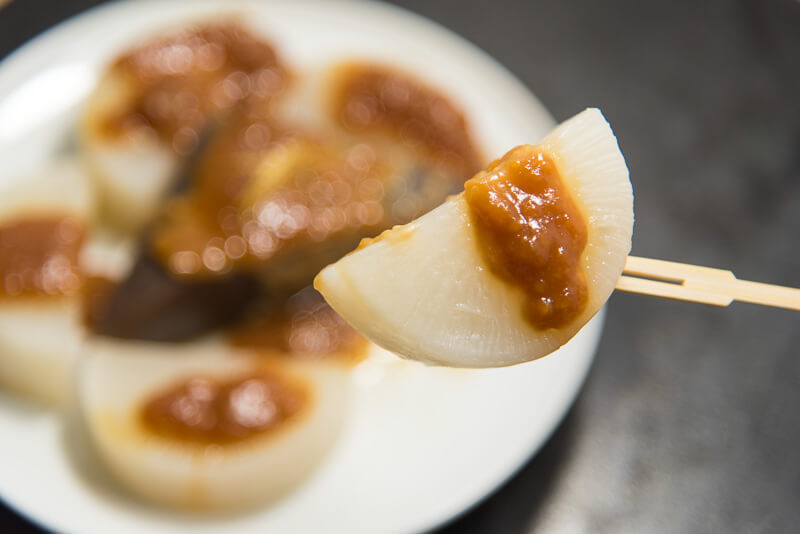
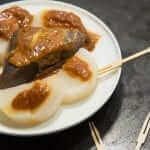
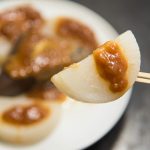
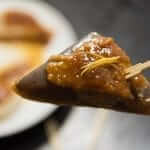
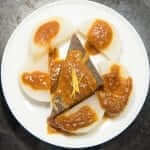




Konnichiwa! (Hello!) I'm Pat Tokuyama, a Japanese tofu cookbook author, who travels for music, food, and adventure. If you like Japanese tea, checkout some of the newestorganic japanese tea, matcha bowls and noren and more!
** Curious about the Plant Based Japanese Cooking Club? ** Learn more here!